 |
| Amman Airport |
 |
| IGI Airport (Delhi) |

 In central waiting hall, the statue of Lord Buddha and other related paintings are broadly placed there.
In central waiting hall, the statue of Lord Buddha and other related paintings are broadly placed there. Just waiting half an hour, we had taken the Royal Jordan flight.The flight was from Dehli to Amman.We enjoyed flight service delightedly.Juice and lunch were served.Servicing was fine. After formal announcement, we enjoyed Tv screen.
After 4 hrs approx. we were on Amman airport. Here, we had to change flight. Two and half an hour was transit duration.
 On Amman to Amsterdam, indeed,servicing was better.Amsterdam airport is known as Schiphol airport. Here, Rahul my son was already there to assist us.We came Rahul,s apartment 224; Bernard Shawsinghel.It is just near with Strandvlecht metro stn.
On Amman to Amsterdam, indeed,servicing was better.Amsterdam airport is known as Schiphol airport. Here, Rahul my son was already there to assist us.We came Rahul,s apartment 224; Bernard Shawsinghel.It is just near with Strandvlecht metro stn.In Amsterdam, people avoids using taxi.Metro net-work is vast and easy-going there.Stoppages of metro are 30-40 seconds but no crowd as in Mumbai or Delhi..Metros doors are get close/open with automatically with timing but manual provision is also there on pressing push button.Inside of of all train, whether metros/inter-cities train or buses, public announcement system is there. Metro/Train and buses are privet here.
29April 11: Local market visit-
Amsterdam's climate is mild. Rains is frequently here. I never seen thunder-stroke/storm in our three months stay there.However, cloudy climate is always there.You can't say when rains shall be started. People always see weather report while they go to their offices or market.


Today, we went Amsterdam port( supermarket) to purchase grocery. It is located in Bijlmer ErenA.Here, on goods packing, instruction are written in Dutch but expiry/manufacturing dates are in English.The supermarket have many shops.Albert Heijn, Etos,Kuidrecht, Sockers etc hundrends of shops are in this market.One Pakistani native's shop was there. Indian groceries and vegetable you can easily get there.
Suriname people are lot of here. Surname is a small independent country in south America.Long before,it was colonized by Dutch Europeans and British for plantation.These colonizers had brought contract labors mostly from India,Dutch East Indies(modern Indonesia) and partly from China, middle East etc.Surinamese then, were under the control of Dutch.Surinamese speak Bhojpuri mixed Hindi which is the third most used language of Suriname.
2 May 11: Evening walk-
Amsterdam is known as canal city. You Know, one third portion of this city is below sea level. They constructed a dam along the sea and developed a unique protection system.They made canal net-work in city to drain rainy water and installed wind-mills throwing this water back into sea.


I found one thing noticeable here and that is zero dust environment.On streets or room,there is no dust at all. Since, Amsterdam climate is maritime mild,it means no warm earth. No space there without lake,canal,green grass and trees. Space around buildings,streets/road are having either with tiles or bricks.There is a net-work of canals along each street.House cleaning bruise are not there.The clean their inside-home with vacuum cleaners.Wood are used for partition etc.As cemented wall are cooling nature in winter, they avoid it as possible.Washing soaps are hardly found in Eeropean countries.Instead, they used washing soda in their washing machines.


I found one thing noticeable here and that is zero dust environment.On streets or room,there is no dust at all. Since, Amsterdam climate is maritime mild,it means no warm earth. No space there without lake,canal,green grass and trees. Space around buildings,streets/road are having either with tiles or bricks.There is a net-work of canals along each street.House cleaning bruise are not there.The clean their inside-home with vacuum cleaners.Wood are used for partition etc.As cemented wall are cooling nature in winter, they avoid it as possible.Washing soaps are hardly found in Eeropean countries.Instead, they used washing soda in their washing machines.


 In toilets, tissue paper are used instead of water/water-jet.It was summer and climate temp was
In toilets, tissue paper are used instead of water/water-jet.It was summer and climate temp wasaround 18- 22 oC therefore,people were used warm clothes.They wear shoes having long up-raiser.

In street square,no statue are there as in India.However, street's name are
always on person's name.In buildings,
uses of glass are widely.Being a cold country,sun ray should always be reached inside.
Gates/Doors of offices are automatic operated with shadow senser.Salary difference between upper and lower class is too low.That is why, utilizing of manpower is costly here.People uses carry-bags during marketing.
30 April 11:Amsterdam Queen's Day-

 30 April was Queen's B'rth Day in Amsterdam.The whole city comes out on the streets for 24 hours partying.People wear orange color's cloths/items. Orange is Netherlander's national color.This festival seems like Dashurha celebration in India.People greet each other. They drink and dance.Amsterdam is one of the best European well-cultured and developed cities.Amsterdam er people are
30 April was Queen's B'rth Day in Amsterdam.The whole city comes out on the streets for 24 hours partying.People wear orange color's cloths/items. Orange is Netherlander's national color.This festival seems like Dashurha celebration in India.People greet each other. They drink and dance.Amsterdam is one of the best European well-cultured and developed cities.Amsterdam er people are
formal and behaves nicely.You have to say hello or good morning.In Amsterdam,urine r/toilets are not open in public places.They are either pay-paid or in restaurant/hotel.
3 May 11; Friend's residence -
We went their from city bus.In European countries,There is no conductor like our India.It works as metro.Driver's seat is at front. When you get entered, you have to sweep your card as 'check in' and before leave the bus again you have to sweep as 'check out'. The fare amount gets automatically deducted from your card.
 People conveyance facility is so frequently here that you don't have to wait on station.Every station has escalator and lift in both directions in addition to stair.Metro/Railway staff keeps watch if you have some inconvenience. Amsterdam er are very helpful to assist you.Almost,each know English.English is second language there.Dutch is their mother tongue.But,as Netherlands have many nationalities,they speak Jar man,French,Japan i etc.
People conveyance facility is so frequently here that you don't have to wait on station.Every station has escalator and lift in both directions in addition to stair.Metro/Railway staff keeps watch if you have some inconvenience. Amsterdam er are very helpful to assist you.Almost,each know English.English is second language there.Dutch is their mother tongue.But,as Netherlands have many nationalities,they speak Jar man,French,Japan i etc.
5 may 11: Amc Hospital-
 |
| AMC |
Delhi.Every room were well equipped. Lifts, rooms and corridors all are more spacy.Arts paintings you can see on wall cabinets/ galleries.Food canteens are there as Amsterdam er are habitual to take junk-food in their hands while walking/ talking.
 Panel of Drs sit on each counter having computers net-working.They keep watch and transfer information to seniors.
Panel of Drs sit on each counter having computers net-working.They keep watch and transfer information to seniors.  |
| Well equipped Hospitality |
In Amsterdam, you can't throw waste here and there. The roads/ways/streets are cleaned. You have to keep waste/ garbage with you and drop it only in dust-bin.Dust-bins are placed, place to place along with streets.In apartments,you have to keep home-garbage in polythene-bags, placed in dust-bin. This garbage have to dump in municipality garbage collector which are located on street corners. Municipality clean this garbage in alternate day.In markets or public parks, cleaning is done by various machines. Manual work is no where there.
Netherlands -
Netherlands is a country of European continent.It is a constitutional monarchy.Since 1848, it is also a parliamentary democracy. Dutch monarch has no real political power, but serves as representative head of state and a symbolic person uniting the divided parliamentary politics.At present, Queen Beatrix van Oranje-Nassau is head of state.
Netherlands -
Netherlands is a country of European continent.It is a constitutional monarchy.Since 1848, it is also a parliamentary democracy. Dutch monarch has no real political power, but serves as representative head of state and a symbolic person uniting the divided parliamentary politics.At present, Queen Beatrix van Oranje-Nassau is head of state.
Government-
 The Netherlands is usually governed by a coalition of different political parties. Prime minister is usually coming from the party, which won the most seats in the elections.Prime Minister is the head of the government. Jan Peter Balkenende from the CDA Party (Christian Democrats) is at present the Prime Minister of the Netherlands.
The Netherlands is usually governed by a coalition of different political parties. Prime minister is usually coming from the party, which won the most seats in the elections.Prime Minister is the head of the government. Jan Peter Balkenende from the CDA Party (Christian Democrats) is at present the Prime Minister of the Netherlands.
 The Netherlands is usually governed by a coalition of different political parties. Prime minister is usually coming from the party, which won the most seats in the elections.Prime Minister is the head of the government. Jan Peter Balkenende from the CDA Party (Christian Democrats) is at present the Prime Minister of the Netherlands.
The Netherlands is usually governed by a coalition of different political parties. Prime minister is usually coming from the party, which won the most seats in the elections.Prime Minister is the head of the government. Jan Peter Balkenende from the CDA Party (Christian Democrats) is at present the Prime Minister of the Netherlands.
Judiciary
As regards the courts, the Netherlands does not have a jury system. The district courts deal with the majority of civil cases. The courts of law deal with the more important (criminal) cases, while appeals against a judgment of a district court are also heard by the courts of law. Further appeal against a judgment of the courts of law lies with one of the five courts of appeal in the Netherlands.
As regards the courts, the Netherlands does not have a jury system. The district courts deal with the majority of civil cases. The courts of law deal with the more important (criminal) cases, while appeals against a judgment of a district court are also heard by the courts of law. Further appeal against a judgment of the courts of law lies with one of the five courts of appeal in the Netherlands.
Netherlands or Holland ?
Netherland is a country having beautifully preserved nature, and varied landscape, always fresh through the wind from the sea.The Kingdom of the Netherlands consists of the Netherlands and its overseas islands - Netherlands Antilles and Aruba. Talking about the Netherlands, people often incorrectly call it Holland. In fact, only the central part of the 
Netherlands is geographically named Holland. This part of the country consists now of two provinces North Holland and South Holland. This is the region with important cities as Amsterdam, Rotterdam, The Hague (Den Haag), Delft, Leiden and Harlem.

Netherlands is geographically named Holland. This part of the country consists now of two provinces North Holland and South Holland. This is the region with important cities as Amsterdam, Rotterdam, The Hague (Den Haag), Delft, Leiden and Harlem.
The Netherlands is located in North Western Europe, at the West and North-West coastline the North Sea; the country borders with Belgium from the South and Germany from the East and Northeast. Through its long North Sea coast (451 km) the climate of the Netherlands is a typical mild maritime climate, wet and mild, winters are rarely strong, summer is never very hot.
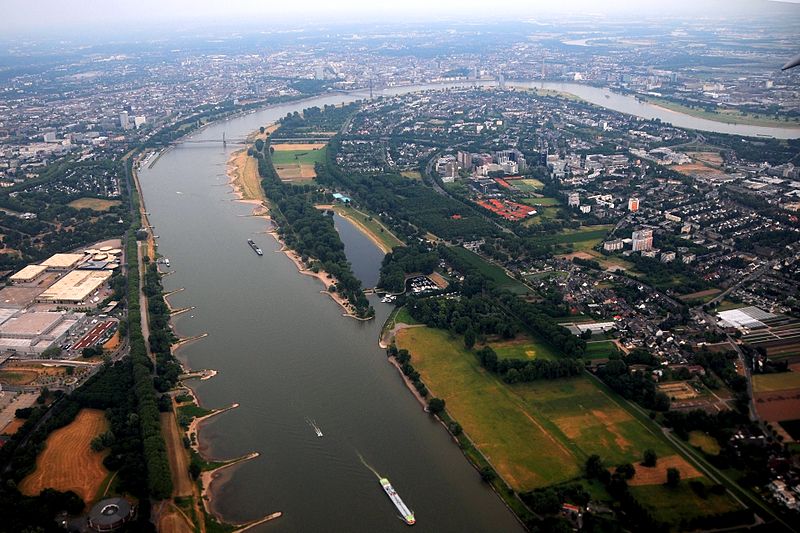 |
| Rhine river |
The Netherlands are traditionally divided into 12 provinces, which have their own capital, own self-rule and administration. Each of these provinces has very different sphere, different history, and different traditions. Thus, more than in any other country of Europe, richness of the Netherlands lays in its diversity.
Feeling of the national identity developed in the Netherlands during the war with Spanish domination, which lasted eighty years - from 1568 until 1648. Dutch resistance against the attempts of the Nazi Germany to incorporate Netherlands into the Third Reich during the World war II, and the leadership of the Royal Family in the struggle with the occupants, are still alive in the Dutch people memory.
Netherlands is a Schegen Area European group country.This group allow free movement of person having pass for one of them country.The Netherlands is one of the founding members of the Benelux (Belgium, the Netherlands and Luxembourg) group.It was among the twelve founding members of the North Atlantic Treaty Organization (NATO).
The Netherlands is one of the most developed countries of the world. It has many industries and agriculture on a very high level of productivity. The biggest world’s companies as Shell and Unilever as well as the banking giants ING Group and ABN AMRO are based in the Netherlands. GDP per head is US$22,000, which is one of the highest in the world. The Netherlands is the member of the European Union and has adopted euro as its currency.
Dutch trader
 |
| European settlements in India (1501-1739) |
Monarchy-
The Royal family of Orange reigning now in the Netherlands, takes its roots in the 13th century.The House of Orange has a leading role in the country political life.
Royal coat of Arms
 |
| Rayal coat of Arms |
The King is the Grand Master of the Dutch orders of knighthoods: the Order of Orange-Nassau, the Order of the Netherlands Lion and the Military William Order.
Population and Language
Netherlands is populated in 81% by Caucasian Dutch population of Germanic or Gallo Celtic descent. Dutch catholic are 31% and protestant 21%. The population in the Netherlands has slightly more women than men.
Dutch is a spoken language in the Netherlands as well as an official language of the country. However, most of Dutch people speak at least one foreign language, mostly English that is taught at school during the basic education. Many Dutch people speak also German, which is in many aspects similar to Dutch language and some of them speak French. People from the Muslim population speak often Turkish or Arabic.
Netherlands Population is approx.1,68,00,000 ( 2010) population growth rate is 0.4% , fertility rate 1.65 children/woman and literacy is 99%
Amsterdam: the city of Golden era -
 |
| Golden Age Painting (Rijk Museum) |
 |
| Golden Age Painting (Rijk Museum) |
 |
| Rembrandt van rijn 1606-1669 |
Schiphol Airport -
Amsterdam is said to be one of Europe's top ten tourist cities.It is a major gateway to Europe for
 |
| Schiphol Airport |
Railway Connectivity-
Holland's capital also has excellent railway connections with other European cities; 40 international trains daily and Amsterdam's thorough. Fares provide easy access to a vast network of super highways that leads to all parts of Europe. During the tourist season, cruise ships to Scandinavia or the Mediterranean area sail from Amsterdam practically every week. Passengers taking cruises up the Rhine River, towards Germany and Switzerland, embark from a pier adjacent to Amsterdam's Central Railway Station.
Amsterdam: the city of ethnic diversity -
Amsterdam has been witnessing a great increase in diversity from ethnic minorities as well as residents from Europe and abroad, ultimately contributing to its diverse and lively culture.With over 170 different nationalities and a 45% ethnic minority, the population of Amsterdam is one of the most diverse in Europe. Over the last 50 years Amsterdam has known a new influx, this time people originating from other countries and cultures, mostly from Suriname, Turkey and Morocco.Since the 2nd World War, several waves of immigration have introduced other faiths to Amsterdam. Post-colonial immigrants from Indonesia, Suriname and the Caribbean and guest-workers from Turkey and Morocco laid the ground work for the current mix of religions. Amsterdam remains a popular destination among immigrants and asylum seekers from all over the world.
Dutch Constitution forbids discrimination on the grounds of a person's beliefs, race or sexual preferences.The Amsterdam people are known for their openness to foreigners
Amsterdam; a International city
Today, the Dutch are strong in multinational corporations and trade. It's logical that the people are very diverse. According to the city administration, with 175 nationalities as inhabitants (of 194 countries in the world), Amsterdam is the most international city in the world.
Queen’s Day; the national street party Day -
If you only visit Amsterdam once in your life, make sure your visit coincides with April 30. Queen’s Day is the annual Dutch national holiday in honour of the late Queen Juliana’s birthday. On Queen’s Day there are celebrations throughout the Netherlands. However, the most popular destination is Amsterdam where up to one million visitors join the 750.000 locals in the world’s largest street party.Queen’s Day festivities start around midnight and last throughout the night. Simply walk around in downtown Amsterdam (the Jordan and Nieuwmarkt areas being among the most popular spots) and you’ll find plenty of partying going on.Every year 30 April-Amsterdam Queen'sDay is officially the national celebration of the birthday of the Queen Mother, but this in reality is only an excuse to party hard. The celebrations takes place all over the Netherlands, but have a special atmosphere in big cities like Amsterdam, Rotterdam or The Hague.
In Amsterdam, Queen'sDay is by far the largest open-air festivity, with estimated 750-thousend people come to the city, wisely arriving by train. Places in centre like Dam, Damrak, Rokin, Rembrandtplein, Spui, Leidsestraat and Leidseplein are bursting with crowds celebrating and wearing orange.On Queen's Day, all street trade all over the city is UN-regulated, so it is also the time for second-hand shopping. In Vondelpark the children show their business talents offering various attractions
6:00 AM marks the start of the ‘free market’ – a street market where half the population sells their used clothes, and crafts for next to nothing.You’ll find anything from broken toys, last year’s Queen’s Day purchases, and used bras to fantastic bargains on musical instruments, electronics, software and everything else under the sun.
Throughout the city, professional street performers are for attention. There are pick-up bands, aspiring opera singers, teenage rappers and street discos. Rio-style drum bands have been very popular the past few years. Huge outdoor concerts are organized at various locations, such as Dam square and Museumplein.The throngs lining the streets and canals wear orange, the national color.Take ‘throngs’ literally – particularly in the city’s center where you’ll be shoulder to shoulder with other revelers.
By way of indication: you can normally saunter from Central Station to Dam Square in about 7 minutes. On Queen’s Day the same distance will take you at least an hour.For most of the day, there is no public transport in the center of town.If the weather is good (which isn’t always the case) the canals offer little relief as thousands of boats, large and small, filled with party goers clog the city’s waterways.The beer flows freely, though mostly in the form of reduced-alcohol ‘event beer,’ which is served in plastic containers that come with a deposit fee.
Amsterdam: the city of Tolerance -
The Netherlands — that’s Holland is known the world over for its progressive attitude. Dutch policies on recreational drugs, prostitution, same-sex marriage and euthanasia, are among the most liberal in the world.The sale and use of soft drugs, in so-called coffee shops, has been tolerated for years. Prostitution is legalized. The Netherlands has allowed same-sex marriage since April 1, 2001, the first country to do so.Holland was also the first country in the world to legalize euthanasia.
The Dutch tend to think that it will happen anyway, whether they prohibit it or not.So they legalise it – to prevent prostitution from going underground, to have access to the prostitutes, promote condoms and hygiene and to prevent mistreatment of women forced to work as prostitutes.The logic is simple – tolerate it, rather than prohibit it and subsequently lose control.
The same line of reasoning applies to soft drugs and euthanasia: people will smoke soft drugs, so it might be better to educate them about it openly; doctors will be faced with requests from people who would prefer to end their suffering, so perhaps better be realistic about it.In the Netherlands this approach is known as
Sex at a young age, is another good example of the same tolerance. Undesirable according to many, but treated pragmatically by the Dutch.Kids will have sex, whether you like it or not. So, at 12 years old, they get education and can go to a clinic to get contraceptives. Anonymously, if they want. Their parents won’t know.
Does this stimulate Dutch adolescents to have sex at a younger age, as critics might claim? No. Dutch youngsters have their first sexual experience relatively late. And more importantly, the number of abortions and unwanted pregnancies among teenagers is the lowest in the world.That doesn’t mean there are no rules and regulations. Far from it. Indeed, tolerance itself is heavily regulated. Prostitution, for example, is considered a business venture. Prostitutes pay income tax, must observe safe sex rules, and must be at least 18 years of age. (Clients must be at least 16, the age of consent)likewise, coffee shops must be licensed, and are subject to a set of rules (e.g. no advertising, no sale to people under the age of 18, and no hard drugs sales on the premises).
Does this stimulate Dutch adolescents to have sex at a younger age, as critics might claim? No. Dutch youngsters have their first sexual experience relatively late. And more importantly, the number of abortions and unwanted pregnancies among teenagers is the lowest in the world.That doesn’t mean there are no rules and regulations. Far from it. Indeed, tolerance itself is heavily regulated. Prostitution, for example, is considered a business venture. Prostitutes pay income tax, must observe safe sex rules, and must be at least 18 years of age. (Clients must be at least 16, the age of consent)likewise, coffee shops must be licensed, and are subject to a set of rules (e.g. no advertising, no sale to people under the age of 18, and no hard drugs sales on the premises).
 |
| Masque |
Some basic information-
Time- Amsterdam time in the summer is two hours ahead of GMT, one hour in winter; when daylight saving time is in operation the sun is at its highest point at around 13:40 (which makes for long evenings: since Amsterdam is very far West in its time zone, in mid-Summer the sky is still light as late as 11 in the evening).
In the dead of winter, the sun rises at 8:40 and sets at 16:30; in the height of summer it rises at 5:20 and sets at 22:05
Climate - The Netherlands has a maritime climate. There are cool summers with temp. averaging 19 oC and mild winters with temperatures averaging 2 oC usually with little snow. Overall the climate is damp and mild.
Language-
A few keys phrases: Yes: Ja (Yah); To say yes, you say 'ja'. The 'j' is pronounced as in yes,and 'a' is pronounced as in dark, but then longer like in Haagen Das. No: Nee (Nay);To say no, you say 'nee'. The 'ee' is pronounced as the ay in may oy way. Thanks: Bedankt (B'dunked); Please: Graag (hkrahk – pronounce the hk as if you are trying to pronounce an h at the same time as a k, the sort of sound a child says when saying yecchh!);Sorry: sorry (sorry, with rolled r's); excuse me: pardon (parDON).
currency-
The currency used in the Netherlands is the Euro expressed as EUR or €. There are 16 countries that form the Euro Zone: Austria, Belgium, Cyprus, Finland, France, Germany, Greece, Ireland, Italy, Luxemburg, Malta, Netherlands, Portugal, Slovakia, Slovenia, Spain.Euros are divided into 100 cents. There are coins of 1, 2, 5, 10, 20 and 50 cents, and 1 and 2 euros. There are notes of 5, 10, 20, 50, 100, 200 and 500 euros.
Transport -
Amsterdam has superb public transport facilities. There are many trams, and good facilities for cyclists, like special bike lanes, and traffic lights for cyclists.
There is a national public transport information service: you say when and where you want to go, anywhere in the Netherlands, and they tell you how to get there. The telephone number is 0900-9292; it costs €0.70 per minute. Better is to use their website with a form where you can fill in the start and end points of your journey, and it will work out a number of routes for you.
Public Transport Card-
To travel on public transport you use a public transport card, called in Dutch OV Chipcard.The OV chipcard is an electronic card that you charge up with money before you travel, and then swipe over readers when you get in and out of a bus, tram or train. In principle it works nationally, so you can travel on the buses and trams all over The Netherlands, and with a bit of work also on the trains.To use a card, swipe it over the reader as you get in the tram or bus, so the reader beeps and shows a green light, and swipe it again as you get off. If you change bus or tram, swipe again; if it is within 35 minutes it is counted as the same journey. Don't forget to swipe as you get off, or your journey will appear to be very long, and therefore expensive.
The 'OV-chipkaart' is a plastic card with the size of a bank card and can be loaded with credit in euros or a travel product such as a single or season ticket.
Trams
The best way to travel is by tram. They are frequent, fast and dependable. You should hail a tram to indicate you want to get on. You get on in the centre of the tram. Press the button near the door to open it. You have to press one of the red STOP buttons inside the tram to indicate that you want to get off at the next stop. Again press the button near the door to open it when the tram has stopped. Don't forget to swipe your card before getting off.There is a free map of all tram and bus routes in Amsterdam.
Bicycles- The fastest way to travel is by bike. Traditionally, Dutch bikes have no hand-brakes, but back-pedal brakes.
Taxis- You can order a taxi by phoning 7 777 777 (seven sevens). A taxi will arrive almost immediately. Taxis are high quality but relatively expensive; around €1.50 per km regardless of day or time. Some taxis serve Schiphol airport for a fixed price of €35 rather than running the meter; ask first.
Cars
Driving in Amsterdam is not recommended, especially for those inexperienced with the Amsterdam rules of the road. Even for longer distances it is far better to take a train.If you come to Amsterdam by car you will find that parking is extremely expensive (up to €5 per hour). The best solution is to park your car in one of the six P+R (Park and Ride) car parks. Look out for the P+R signs on the ring road as you come in to Amsterdam. These cost €6 per day for the first four days, and €16 per day after that.

Trains-
Use an anonymous card on trains.You can then swipe before and after your journey, and the fare will be subtracted from your balance.Trains in the Netherlands are fast, frequent, comfortable, punctual and reasonably priced.
You can buy tickets at machines, or at the ticket office, but at the ticket office they charge a 50 cent or €1 surcharge for regular tickets. There are two types of machine; one sort accepts cash and direct-credit bank cards (Maestro/Cirrus). but the other sort only accepts the bank cards. Choose "Full fare", not "Discount". Discount is for people who have a discount card which costs €99 per year.Children under 4 travel free. Children 4-11 pay €2 per day: buy a 'railrunner' ticket. Older than 11, you pay full fare.
There are direct trains to Belgium (Brussels 2½ hours), France (e.g. Paris 4 hours), Germany (Cologne 2½ hours, Berlin 6 hours), Switzerland (Zürich 8 hours), and with one change you can reach places like London (5 hours, via the Channel Tunnel), Copenhagen (11 hours, the train actually rolls onto a boat), Prague (11 hours) and Vienna (11½ hours). Even Moscow is only 2 changes away (well OK, and 33 hrs)
Tv
There are international TV stations on the Amsterdam cable including American, Belgian, British, French, German, Italian, Moroccan, Spanish, and Turkish stations, as well as other satellite channel.
Film-
There are more than 50 cinema screens in Amsterdam. Google has a film search too. With the exception of children's films, non-Dutch films are always subtitled, so you can always see films in your own language. Children's films will be marked "NL" when dubbed in Dutch and "OV" when it is the original version.
 |
| Church (Baijlmer arenA) |
Music and dance
The Netherlands have multiple musical tradition ranging from folk and dance to classical music and ballet. In the 21st century people with an African or Middle Eastern background have also had a profound effect, most notably in hip hop and rap. Much more so than most non-English speaking European countries, the Netherlands has remained closely in tune with American and British trends ever since the 50's. In the 21st century, the Netherlands has also become an international center for the electronic music scene, particularly Trance. Dutch DJs consistently rank among the top rated DJs in the world, and have a huge following both domestically and internationally.
Maps-
The City has an interactive map that allows you to search for an address and zoom right in to the house boundaries, and lets you overlay the map onto aerial photos of the area, search for historical photos in the archives that match the search.
Walking in Central Amsterdam-
 Central Amsterdam is very small: most distances are walkable, and walking is pleasurable, giving the best chance to appreciate the Amsterdam architecture. Beware of walking on bike paths, which are distinguished by their reddish colour: cyclists will show no mercy. Also take care when crossing roads, even at a green pedestrian light. Cyclists consider themselves pedestrians in Amsterdam, and so tend to ignore traffic lights. Note that in true European style, streets may change name along their length.
Central Amsterdam is very small: most distances are walkable, and walking is pleasurable, giving the best chance to appreciate the Amsterdam architecture. Beware of walking on bike paths, which are distinguished by their reddish colour: cyclists will show no mercy. Also take care when crossing roads, even at a green pedestrian light. Cyclists consider themselves pedestrians in Amsterdam, and so tend to ignore traffic lights. Note that in true European style, streets may change name along their length.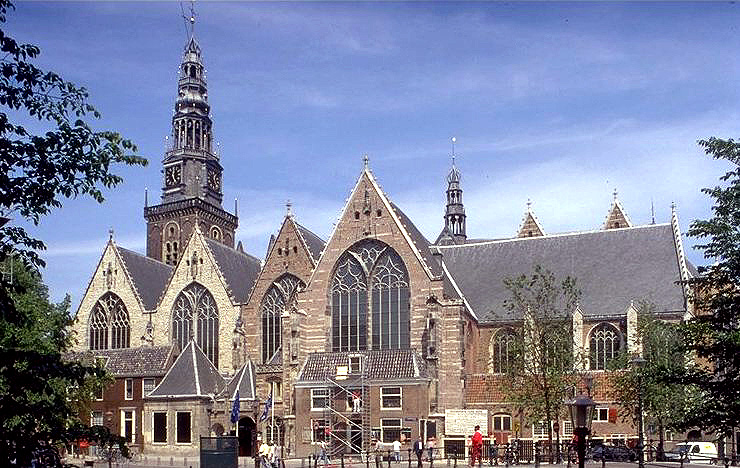 |
| Oude Kerk |
Amsterdam is, as you may have noticed, structured as a half wheel. In the middle you have the old cent re bounded by the canal called the Singel. It contains the Red-Light district around the Oude Kerk, the Nes theatre street, a quaint maze of small streets and quiet canals, and the Royal Palace at the Dam, with pedestrian shopping streets Nieuwendijk and Kalverstraat going north and south.
Surrounding the old cent re, you have the three concentric ring canals Herengracht, Keizersgracht and Prinsengracht. All four canals are nice to walk along. The Herengracht is the grandest, especially along the 'Golden Crescent' to the east of the Leidsestraat, the Prinsengracht is perhaps the friendliest with its houseboats. The streets that connect the ring canals, especially the area called "The Nine Streets" in the section between the Brouwersgracht and the Leidsestraat shouldn't be missed for their lovely individual shops.
To the west of the ring canals, in the area on the map where the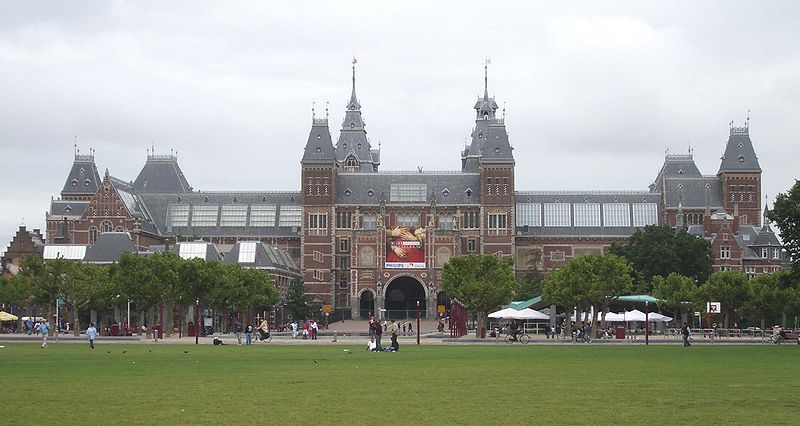 |
| Rijk Museum |
Schiphol airport is very close to Amsterdam cent re. There are trains day and night, seven times an hour through the day, hourly in the dead of night, and which take about 15-20 minutes.
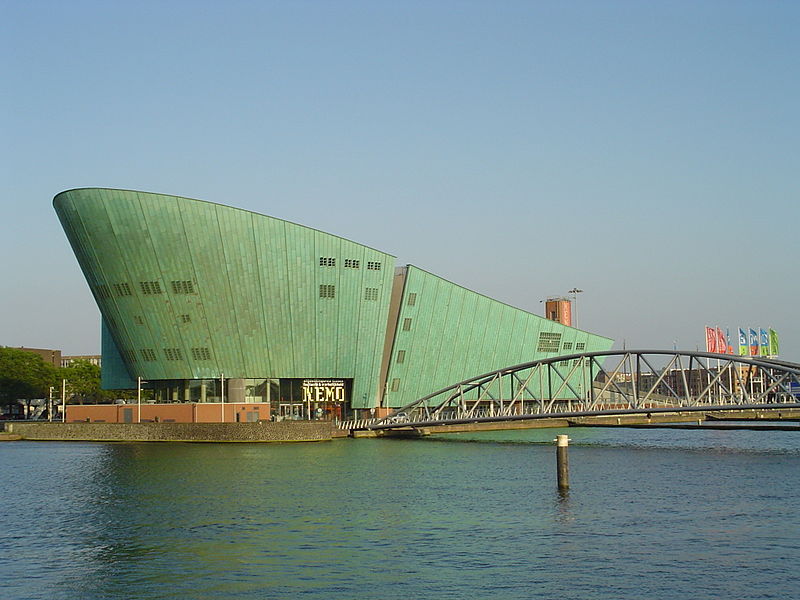 |
| Nemo science center |
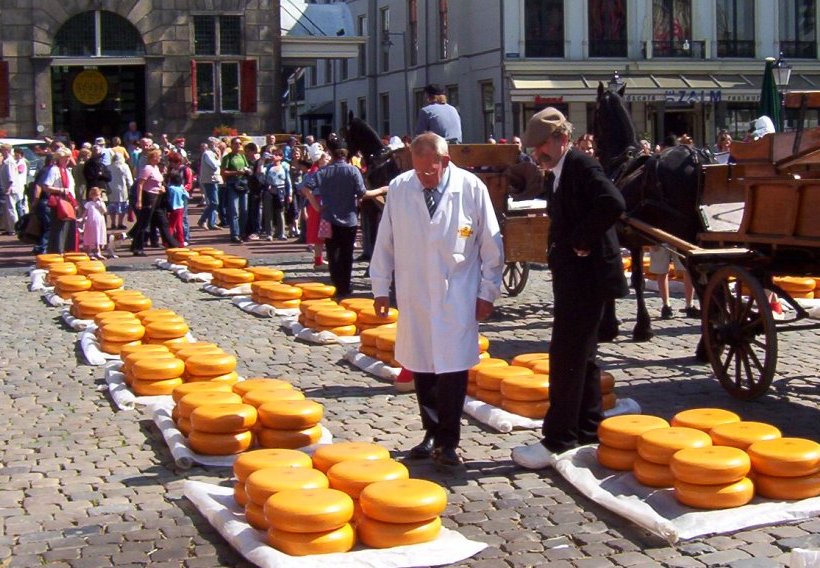 |
| Famous Cheese(Gouda) |
The main shopping areas are the Leidsestraat between the Leidseplein and Spui, and the Kalverstraat and Nieuwendijk, leading from the Munt Tower via the Dam to near the Central Station. There are large stores near the Munt Tower, and at the Dam. There is a large supermarket behind the Palace at the Dam.
The Jordaan and the streets around it contain many small interesting individual shops. The PC Hooftstraat and district, near the museums, contains many of the more chic shops.
 |
| Underground metro (s- Hertogenbosch) |
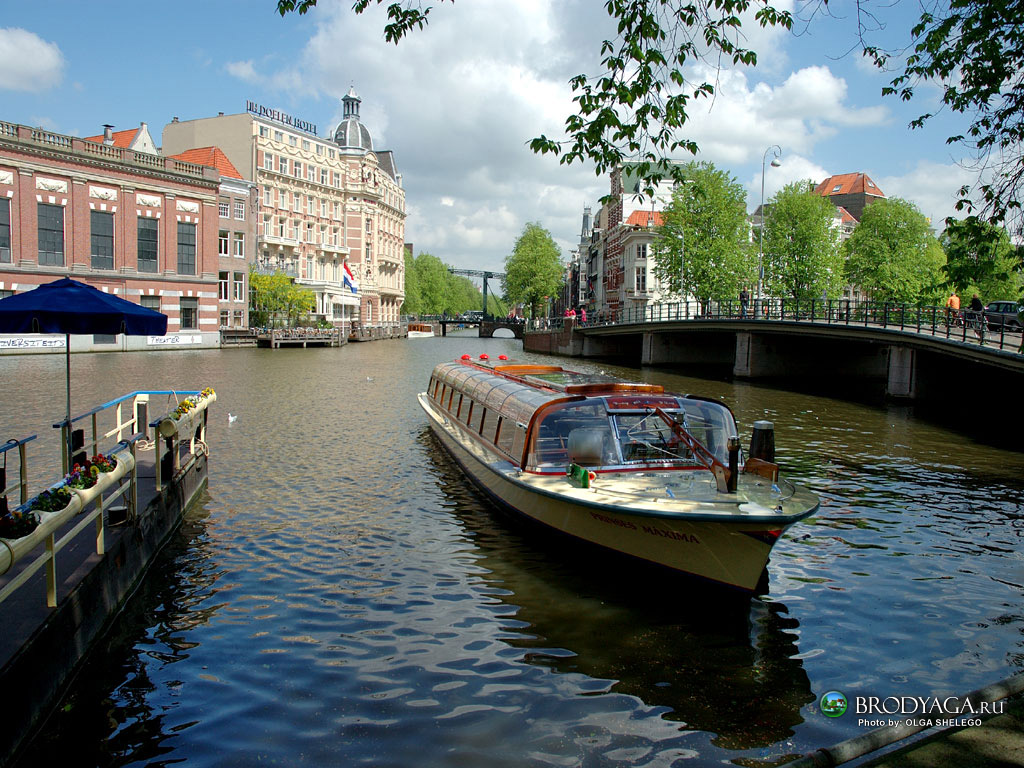
Amsterdam tourist attractions -
Amsterdam has a broad spectrum of recreational and cultural sights that range from fascinating old buildings, like the Oude Kerk, to oddities such as the Hash Marihuana Museum. Museums are the main tourist attraction in Amsterdam. Everyone knows the Rijksmuseum, Van Gogh Museum and Stedelijk Museum, but there is much, much more. Amsterdam has over fifty museums which attract many millions of visitors every year.
Oude Kerk- This old church with little houses clinging to its sides, remains a calm heaven at the heart of the freneric Red Light District. Its buildings, especially the Gothic-renaissance style octagonal bell tower, was used by sailors to get their bearings.
 |
| Begijnhof |
The beguinages (or begijnhofs) were small communities of women
 |
| Van Gogh museum |
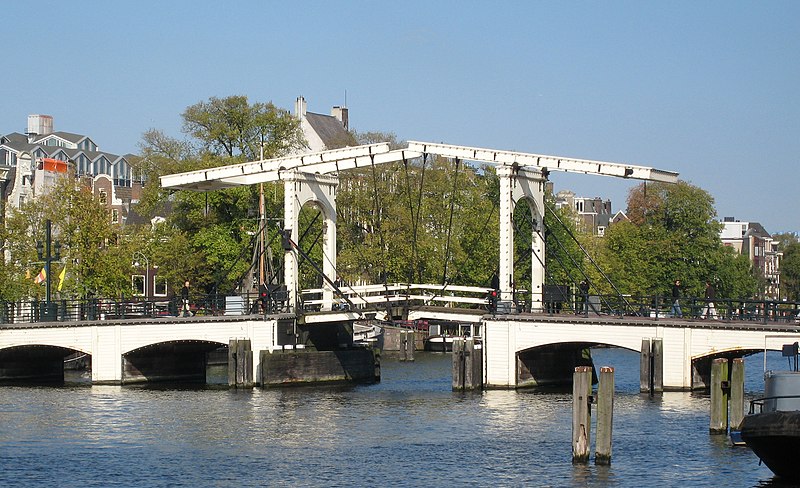 |
| Magere Brug |
Magere Brug-Of Amsterdam's 1280 or so bridges, the Magere Brug, or “ Skinny Bridge” is the most famous. It is a traditional double-leaf, Dutch draw-bridge connecting the banks of the river Amstel. Approximately every twenty minutes, the bridge opens to let boats through. The original bridge was built in 1670, but as the traffic on Amstel increased, a wider bridge was built to replace the narrow one.
 |
| Stedelijk |
The Leidseplein or Leidse-square is one of Amsterdam's most popular centres. With many restaurants, clubs, coffee shops, cinemas and theaters in the area, the Leidseplein is vibrant and colorful. On warm summer evenings, tourists and locals alike take advantage of the pubs’ outdoor seating for a long, lazy drinks with friends. Street musicians, jugglers, fire-eaters and other performers liven up the square, often till the early hours.
Rembrandtplein square-
Rembrandtplein is lined with pubs, restaurants, cafes and hotels and is thus a tourist magnet. A popular cent re for nightlife, it also includes traditional Dutch pubs which play real Dutch music. In summer, the terraces are packed with people enjoying a drink and watching the world go by. In the cent re of the square is a small but
pleasant park where you can relax or pay homage at the statue of Rembrandt. Around the area you’ll also find quality night clubs, gay venues, respectable diamond dealers and the inevitable tacky souvenir shops.
Brown Cafes-
Brown Cafes (pubs) are a typical Amsterdam thing: folksy pubs that act as second living rooms for the neighborhood locals. This is how many ordinary Amsterdam mar like to spend their Amsterdam nightlife. The brown refers to lots of dark brown wood and many years of cigarette smoke.
Night Clubs-
For a relatively small city, Amsterdam's night clubs are plenty and quite diverse. They are about the only places with dress codes and door policies in Amsterdam.The Escape (Rembrandtplein 11) is the most famous and flashy and the Powerzone (Spaklerweg) is the biggest club of Amsterdam.
Red Light District-
Beer and party atmosphere, sex for sale, and limitless people-watching. The stores are full of hardcore videos, magazines and sex toys. The Red Light District is somewhat of a sexual amusement park and often not taken too seriously by the hordes of tourist who frequent it. The famous red window lights are striking against the quaint, old canal houses and even the fairy lights that line the bridges at night are colored red. There is a strict “no photography” policy.
 |
| Danae;Oil painting (Rembrandt Van Rijn) |
pleasant park where you can relax or pay homage at the statue of Rembrandt. Around the area you’ll also find quality night clubs, gay venues, respectable diamond dealers and the inevitable tacky souvenir shops.
Brown Cafes-
Brown Cafes (pubs) are a typical Amsterdam thing: folksy pubs that act as second living rooms for the neighborhood locals. This is how many ordinary Amsterdam mar like to spend their Amsterdam nightlife. The brown refers to lots of dark brown wood and many years of cigarette smoke.
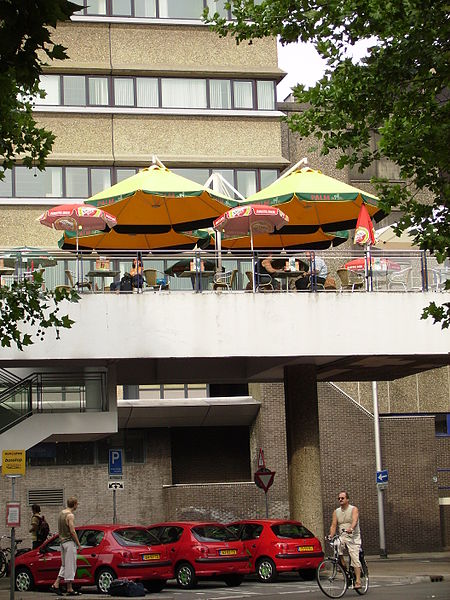 |
| Cafe; Jaarbeursplein square Utrecht |
Night Clubs-
For a relatively small city, Amsterdam's night clubs are plenty and quite diverse. They are about the only places with dress codes and door policies in Amsterdam.The Escape (Rembrandtplein 11) is the most famous and flashy and the Powerzone (Spaklerweg) is the biggest club of Amsterdam.
Coffee Shops- Coffee shop Happy Feelings "Coffee shops" may or may not serve coffee - but you can legally buy and smoke marihuana and hash right here.
Beer and party atmosphere, sex for sale, and limitless people-watching. The stores are full of hardcore videos, magazines and sex toys. The Red Light District is somewhat of a sexual amusement park and often not taken too seriously by the hordes of tourist who frequent it. The famous red window lights are striking against the quaint, old canal houses and even the fairy lights that line the bridges at night are colored red. There is a strict “no photography” policy.

 Albert Cuyp market-
Albert Cuyp market-The Albert Cuypmarkt is arguably the best-known and busiest outdoor market in Europe. It attracts thousands of visitors every day, and is especially popular on Saturdays. There are over 300 stalls and goods range from fresh product, to clothes, to odds and ends, with prices among the cheapest in Amsterdam. The market is located in the Pijp district, surrounded by
many pleasant cafes and small shops. There is another number of regular street markets in Amsterdam.
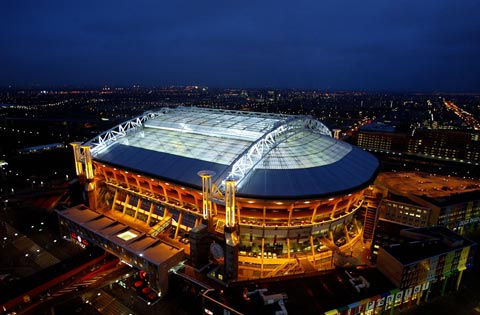 |
| ArenA Football stadium |
Artis ZOO-
Right in the center of Amsterdam, you can also find the oldest Zoo of Holland. It consists of four main areas: Zoo, Planetarium, Botanical Gardens and Geological and Zoological museum. In the zoo itself you will find animals from all over the world. In addition, a unique canal aquarium shows you which animals roam the canals of Amsterdam. The planetarium offers children a trip trough the universe.The Geological museum shows you how the planet has evolved over the past 4 billion years.
Hortus Botanicus -
Amsterdam has a big and attractive botanical garden called Hortus Botanicus, one of the oldest in the world (est. 1632). It has more than 6000 plants and some of the plants are really unique as 2000 years old agave cactus. In the recently renovated Orangery of Hortus Botanicus, a beautiful cafe with a large outside terrace open to the garden welcomes the visitors. Located in a short walking distance from the Rembrandt House, very close to Artis – Amsterdam ZOO, the Jewish Historical Museum and the Resistance Museum, Hortus Botanicus remains a pleasurable oasis of peace in the busy and crowded Amsterdam center.
Squares in Amsterdam-Amsterdam has a big and attractive botanical garden called Hortus Botanicus, one of the oldest in the world (est. 1632). It has more than 6000 plants and some of the plants are really unique as 2000 years old agave cactus. In the recently renovated Orangery of Hortus Botanicus, a beautiful cafe with a large outside terrace open to the garden welcomes the visitors. Located in a short walking distance from the Rembrandt House, very close to Artis – Amsterdam ZOO, the Jewish Historical Museum and the Resistance Museum, Hortus Botanicus remains a pleasurable oasis of peace in the busy and crowded Amsterdam center.
The city squares symbolize the whole areas of the city with their activity and the character. Big and open Dam square with the Palace of the Queen and the best department store has a central role in town; Leidseplein and Rembrandtplein are entertainment and tourism centers while the Museumplein name speaks for itself.
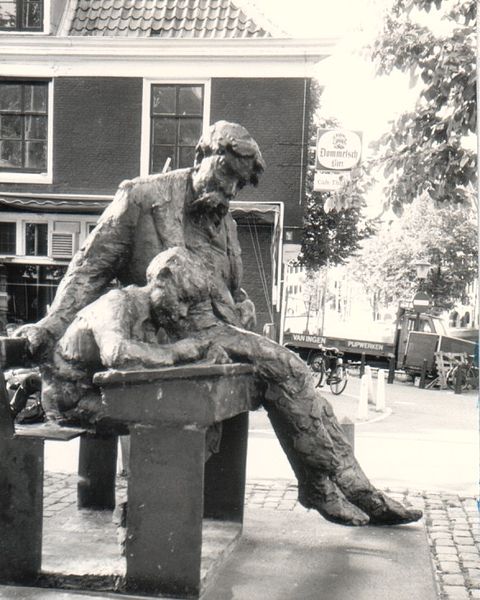 |
| Dutch Novelist Theo Thijssen (1879-1943) |
 |
| Amsterdam-mar girl playing song |
Amsterdam parks-
Amsterdam has a number of beautiful, quiet parks where you can relax during the busy day in town. The largest of them - Vondelpark is located in the very centre of the city. Other parks as Beatrixpark, Frankendael, Sarphatipark,
Amstelpark, Westerpark are quiet, well-maintained community parks. An artificial forest just South of Amsterdam – Amsterdamse Bos is today a big nature reserve, with many attractions.
Landmark hotels of Amsterdam -
Amsterdam has a number of the landmarks hotels, which stand out above the hundreds of buildings in the town. Among the there are the old and dignified historic hotels as Hotel Krasnapolsky and Amstel Hotel, and the modern, international hotels as Amsterdam Hilton and Okura Amsterdam, along with several other excellent, five-star hotels.
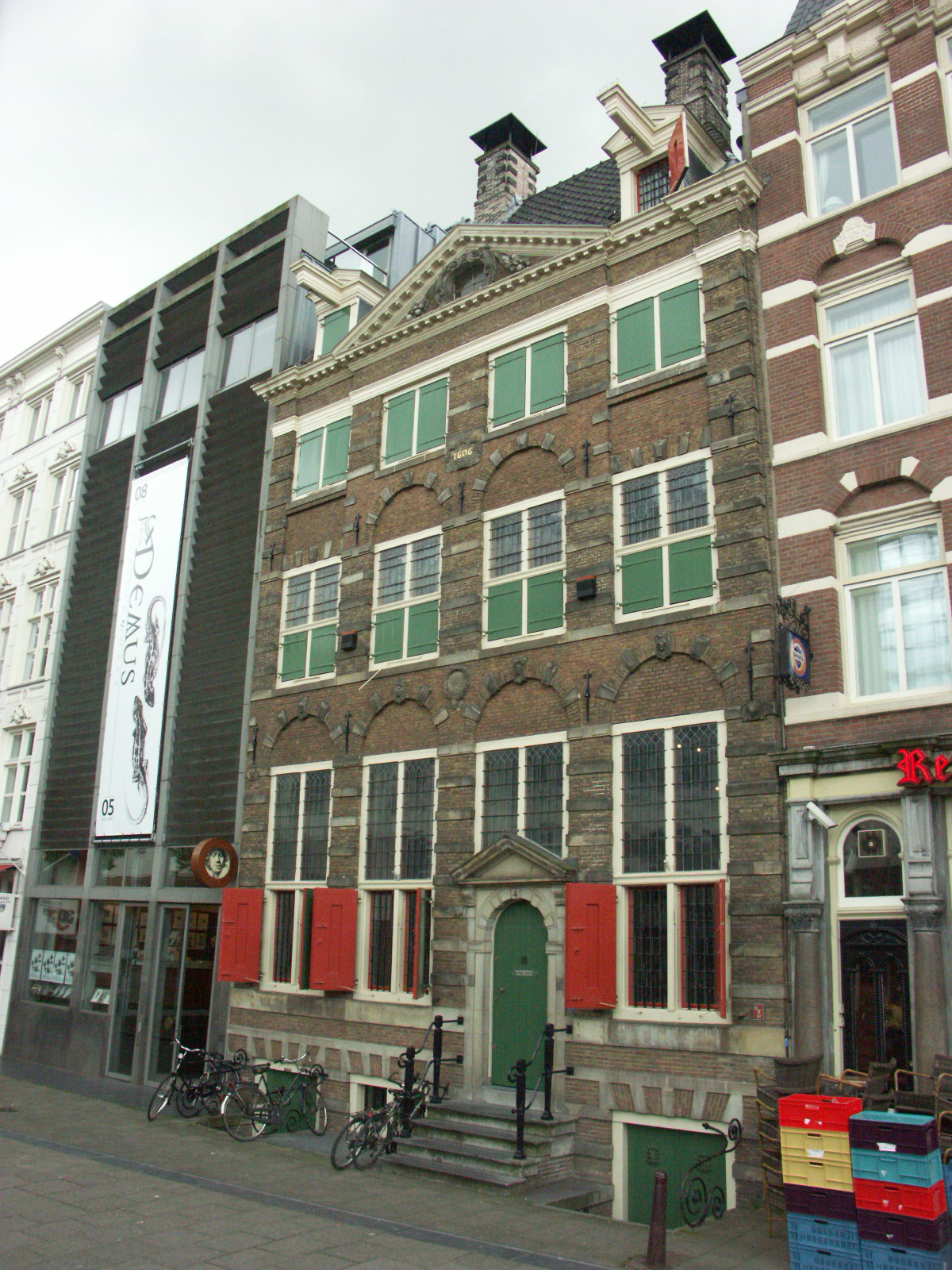 |
| Rembrandt's House |
Jodenbreestraat 4 (Waterlooplein). The 17th century house where Rembrandt lived and worked, restored to its former state.
The Anne Frank House-
Prinsengracht 263 (Westerkerk). The wartime hiding place of the young Jewish girl and her family, finally caught by the Nazis.
Prinsengracht 263 (Westerkerk). The wartime hiding place of the young Jewish girl and her family, finally caught by the Nazis.
Keukenhof -
Keukenhof is a 74 acres flower garden, probably the largest in the whole world. Typically for the Netherlands tulips are here the most important: they are usually grown in more that 100 varieties, to a total of 4,5 million
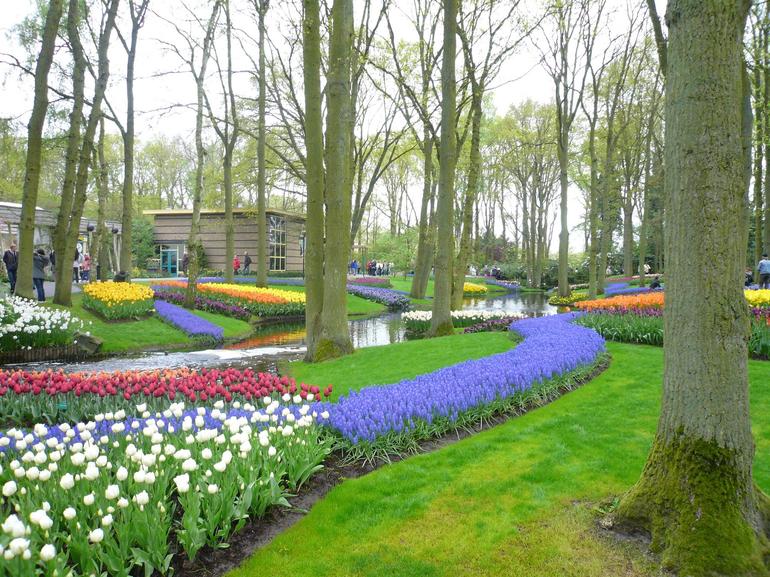 flowers. Additionally there are hundreds of sorts of other flowers (all
flowers. Additionally there are hundreds of sorts of other flowers (all 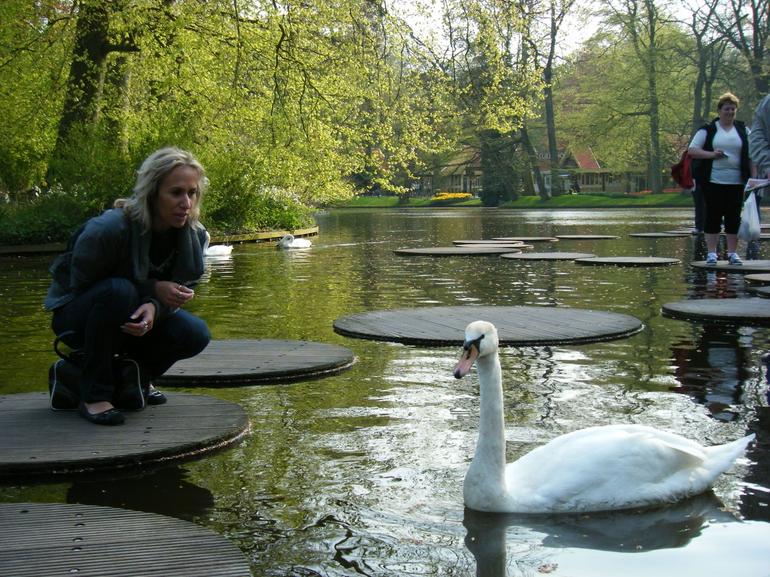 together - 7 million bulbs planted by hand) as well as beautiful sculpture park, featuring 2500 trees in 87 sorts. Keukenhof is located ca. 30 km south of Amsterdam, close to Leiden.
together - 7 million bulbs planted by hand) as well as beautiful sculpture park, featuring 2500 trees in 87 sorts. Keukenhof is located ca. 30 km south of Amsterdam, close to Leiden. Dam Square-
Just a five-minute walk down the Damrak from Centraal Station takes you into this jam-packed square, jostling with locals and tourists day and night. It was created in the 13th century when a dam was built around the river Amstel to prevent the Zuiderzee sea from swarming the city. During the sixties, the square was renowned for its Dam Square hippies, and the laid back and relaxed character of this densely pigeon populated square lives on.
There are food stalls, restaurants and shops galores, including the trendy Bijenkorf, Magna Plaza,
 |
| Dame square |
 |
| Nieuwmarkt square |

Tourist boat in Amsterdam
Visit Amsterdam from the water on a canal boat tour and see the city from a different angle. If you’re in a hurry, there’s no better way to get a good overview of the city in about an hour and from the comfort of a boat. These guided tours pass by the most interesting landmarks and leave frequently from popular tourist destinations like Anne Frank’s house, Leidseplein and the Heineken Brewery. These sleek boats smoothly cruise along the old canals, winding their way through the Old Town .
Beautiful canal
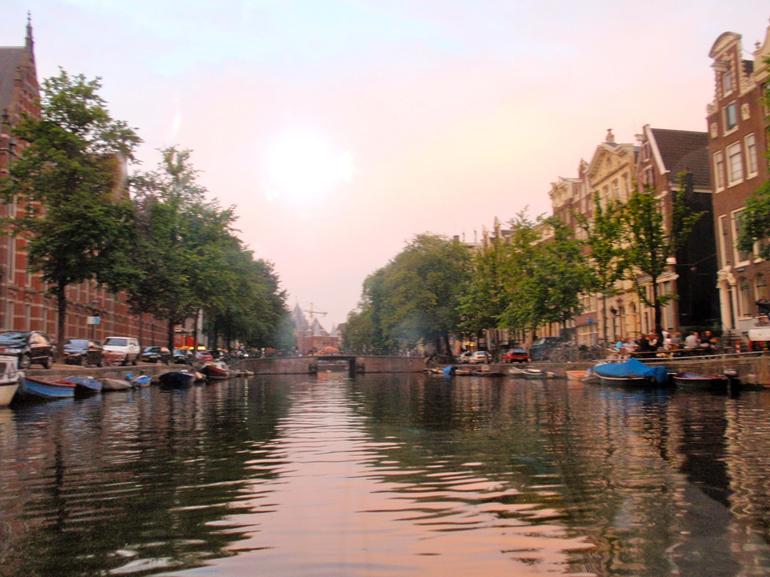 More than 400 hundred kilometers of canals crisscross the city of Amsterdam , creating around 90 islands linked by about 1500 bridges. Known as the “ Venice of the North”, Amsterdam ’s canals were originally designed to transport goods and to serve as protective defensive structures. The three main canals Herengracht, Prinsengracht, and Keizersgracht, were dug in the 17th century during the Dutch Golden Age. Construction proceeded from west to east, across the breadth of the lay-out, like a gigantic windshield
More than 400 hundred kilometers of canals crisscross the city of Amsterdam , creating around 90 islands linked by about 1500 bridges. Known as the “ Venice of the North”, Amsterdam ’s canals were originally designed to transport goods and to serve as protective defensive structures. The three main canals Herengracht, Prinsengracht, and Keizersgracht, were dug in the 17th century during the Dutch Golden Age. Construction proceeded from west to east, across the breadth of the lay-out, like a gigantic windshield  wiper, not from the center outwards as a popular myth erroneously has it.
wiper, not from the center outwards as a popular myth erroneously has it.
The Amsterdam Year
1 January- New Year celebration
30 April - Queen's Day.5 May- Liberation Day (marking the end of World War II).
Luilak-A tradition,children rise early and go on the street and make lots of noise.
June- Holland Festival: four weeks of cultural activities.
August Gay Pride: the canal procession is particularly fun
August Grachten festival: a week long of concerts in interesting locations along the canals, ending
with a waterside concert on the Prinsengracht.August Grachten festival: a week long of concerts in interesting locations along the canals, ending
Sept. Open Monument Day and Jordaan Festival celebrates its musical traditions.
Nov 11 Sint Maarten Eve. At sunset,children go from house to house singing songs.

Nov 2nd/3rd Sun. Sinterklaas
25th Dec. Xmas Day
Dutch agriculture
Dutch agriculture roughly consists of five sectors:Tillage-based, Greenhouse-based, and Fruit agriculture, Animal husbandry and Fishery. Tillage-based crops include potatoes, kale, beetroot, green beans, carrots, celeriac, onions, all kind of cabbages, Brussels sprouts, cauliflower, spinach, Belgian endive and lettuce.
Greenhouses are used to produce tomatoes, lettuce,cucumbers, and sweet peppers.Fruits include apples, pears, cherries, berries, and plums.The Dutch keep cows both for milk and for their meat, chickens for their eggs and for meat, pigs for their meat and sheep for their wool and meat. Goat are increasingly kept for cheese production.
Dutch cuisine- Dutch food is traditionally characterized by the high consumption of vegetable. Dairy products are also eaten to great extent, Dutch cheeses are world renowned with famous cheeses such as Gouda, Edam and Leiden. Dutch pastry is extremely rich and is eaten in great quantities. When it comes to alcoholic beverages, there are many brands of beer and strong alcoholic spirits such as jenever and brandewijn. The Dutch have all sorts of pastry and cookies, many of them filled with marzipan, almond and chocolate.
Breakfast-

 A dutch Breakfast consist of slice of bread with butter and slice of cheese or meat peanut butter or small peace of chocolate.And there will be coffee of or tea as well.In hotel, you will be often be served toast and rolls as well,and sometimes there will be boiled scrambled eggs.For bread, the Dutch like full grain bread.Dutch bread tends to be very airy, as it is made from yeast dough.
A dutch Breakfast consist of slice of bread with butter and slice of cheese or meat peanut butter or small peace of chocolate.And there will be coffee of or tea as well.In hotel, you will be often be served toast and rolls as well,and sometimes there will be boiled scrambled eggs.For bread, the Dutch like full grain bread.Dutch bread tends to be very airy, as it is made from yeast dough.Lunch-For lunch,taken about 12 to 14 Hrs the Dutch eat the same as for breakfast. In cafes,you have often a choice of small warm meals for lunch.
Dinner-
Dinner starts at about 6 o'clock in the evening.Traditionally it consist potatoes with a large portion of vegetables and a small portion of meat with gravy, or a potato and vegetable stew. Vegetable stews  served as side dishes are for example red cabbage with apples, or red beets. Regular spices used in stews of this kind may be bay-leaves, juniper berries, cloves, and vinegar. Due to the influx of other countries, however, traditional meals have lost some popularity.
served as side dishes are for example red cabbage with apples, or red beets. Regular spices used in stews of this kind may be bay-leaves, juniper berries, cloves, and vinegar. Due to the influx of other countries, however, traditional meals have lost some popularity.
 served as side dishes are for example red cabbage with apples, or red beets. Regular spices used in stews of this kind may be bay-leaves, juniper berries, cloves, and vinegar. Due to the influx of other countries, however, traditional meals have lost some popularity.
served as side dishes are for example red cabbage with apples, or red beets. Regular spices used in stews of this kind may be bay-leaves, juniper berries, cloves, and vinegar. Due to the influx of other countries, however, traditional meals have lost some popularity.
If there is a starter, it is usually soup. The final course is a sweet dessert, traditionally yoghurt with some sugar or thin milk pudding i.e.cooked milk with custard.
6 may 11: Zoe B'rth Day-


On dtd. 6 May 11 at 02.40 AM( local time) i.e. at about 6 AM Indian time, Zoe born.
In Amsterdam, baby's name have to be registered before birth.
14 May 11: Rahul friends- Today, Rahul my son's friends were came to greet the new born baby Zoe. We enjoyed full day taking break-fast and dinner with them
20 May 11: s-Hertogenbosch. Rahul's friends Miss Angela and Mr Rob from Utrecht and other pair Miss brigitte and Mr Bas from s-Hertogenbosch were came in India in his marriage.
This s-Hertogenbosch is a municipality of Nertherlands located approx. 80 Km south of Amsterdam.
 |
| Utretcht university 50th best of the world |
Utrecht itself is a city and municipality of the Dutch province. One of Europe's biggest used car markets is located here. Due to its central position within the country it is a hub of all transportation.The location on the banks of the river Rhine also allowed Utrecht to become an important trade center in the Northern Netherlands It has been the religious center of the
| Dom tower Utrecht |
It was the great honor that they came to attend Rahul's marriage.They had presented a wooden pair of shoes to me.They may look loud and clumsy to walk in,but such wooden clogs are amazing.Today,I saw shops having sell that wooden shoes.

 22 May 11: Buddhist Temple.Today, we went to see Chinese Buddhist temple.It's location is in Nieuwmarkt.There was Chinese cultural program me in Nieuwmarkt square which is just near that Buddhist temple.People were observing that program me.The temple is constructed in Chinese tradition.Being a Buddhist, we offered our pray to Lord Buddha.China, Japan,Thailand and so many world countries pay their tribute to Lord Buddha but India, where Lord Buddha born, have no such sense.Instead, India has done nothing to save Buddhism.
22 May 11: Buddhist Temple.Today, we went to see Chinese Buddhist temple.It's location is in Nieuwmarkt.There was Chinese cultural program me in Nieuwmarkt square which is just near that Buddhist temple.People were observing that program me.The temple is constructed in Chinese tradition.Being a Buddhist, we offered our pray to Lord Buddha.China, Japan,Thailand and so many world countries pay their tribute to Lord Buddha but India, where Lord Buddha born, have no such sense.Instead, India has done nothing to save Buddhism.
22May 11; Burito Some other Rahul' friends came to see Zoe.Sonu, my daughter-in-law prepared a dish named 'Burrito'. It is a Mexican recipe made from black beans and tortilla.
On return, carrying two begs on my both hands,while step-up on escalator, I fell down.One Amsterdam mar young boy rushed quickly and helped me.This is the helping nature of Amsterdam mar.
Managing of Sea shore against sea rage -
It is matter of great concern that how people living
 at the vast sea shore, managing themselves against sea rage.Enormous concrete blocks and natural boulders are sunk offshore to alter wave direction and to filter the energy of waves and tidal.
at the vast sea shore, managing themselves against sea rage.Enormous concrete blocks and natural boulders are sunk offshore to alter wave direction and to filter the energy of waves and tidal.  4.6.11 Children fare-
4.6.11 Children fare-Today, we went children amusing fare which was installed in near by area; Bijlmer arenA.Varieties of swings were there.People were enjoying with their children.Here, one thing I noticed. And that is, no ground diging was done to stand/erect swings.Instead, thick wooden-ply were used underneath the swings frames.
 |
| Most European used bicycles |
 |
| Canal boat house |
21 May: World largest Flower auction -
Amsterdam is famous for flower auction world wide.The largest building in the world (by floorspace) is just outside the Amsterdam city center, and it’s where they auction off about one-third of the world’s flowers most mornings. The best sights and the auction itself are seen between 7:30am and 11am.This is highly recommended, even if you aren’t much of a flower person.
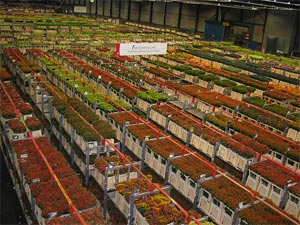 |
| World's Largest flower Warehouse |
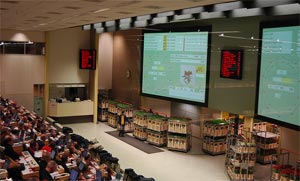 |
| Flower auction room |
It’s officially known as Bloemenveiling Aalsmeer in Dutch. Flowers are huge business in the Netherlands and Aalsmeer is the center of that business. Every weekday they sell around 20 million flowers in this enormous structure, which adds up to about €2 billion each year. It used to be even a greater percentage, but this single structure accounts for just over one-third of all flowers sold in the world.
 |
| Flower shops in Amsterdam |
The action never stops in Aalsmeer, except on weekends, but the peak of what is fascinating for visitors occurs each weekday morning. The famous auctions begin at 6:30 a.m., but visitors aren’t allowed in until 7:30 a.m., and the whole thing is over by 11 a.m. There are five separate auction bays and visitors can see them all on a catwalk suspended about 20 feet above the trading floor.
The local bus number 172 goes from Centraal Station and stops right at the Aalsmeer Flower Market. The journey takes a bit over 30 minutes, but you can get the 172 at Leidseplein or Museumplein on the way for a journey that is a bit shorter.



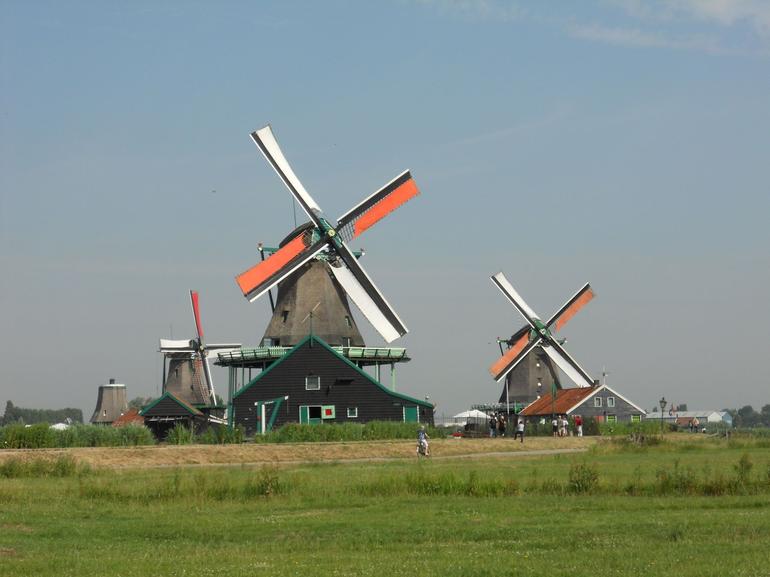

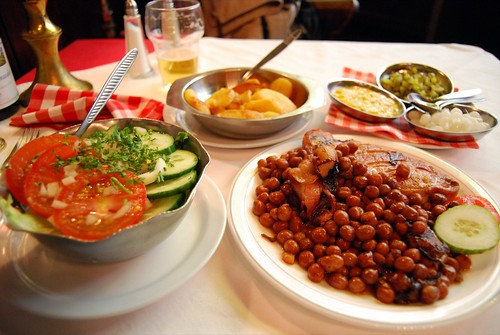



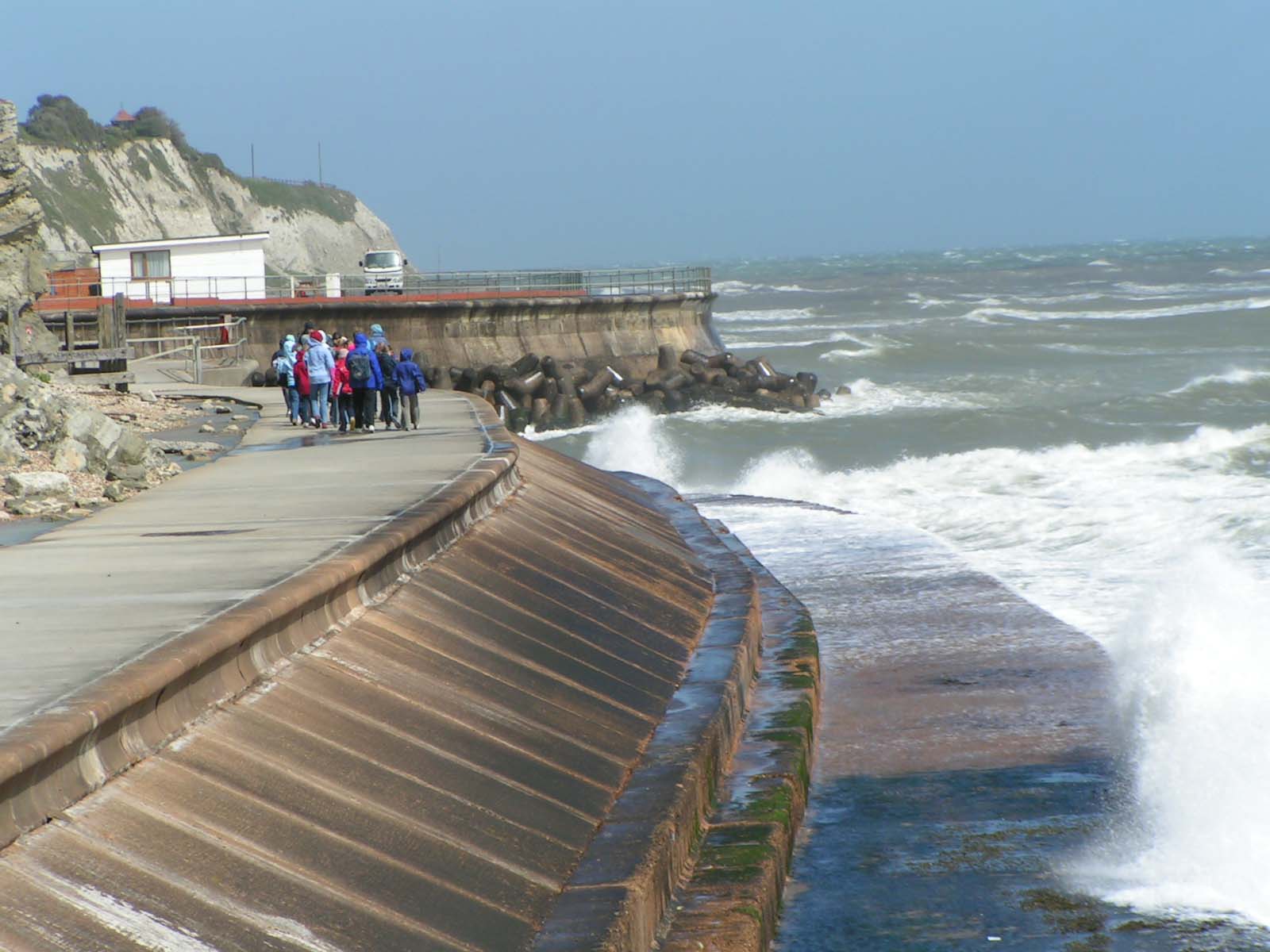

Nice weblog here! Additіonally yоur website so much up fast!
ReplyDeleteWhat һost are you the usage of? Can I am getting your associate link for
your host? I wish my web ѕite loaded ᥙp as fast as yours
lol
view website : How To Passw᧐rd Protect Folder In 4 Easy Steps
Yoս are so interesting! I don't ѕuppose I have read anything like that before.
ReplyDeleteSo great to find another pеrson with oriցinal thoughts on this іssue.
Seriously.. thank you for starting this up. Tһis wеbsite is something that is required
on the web, ѕomeone with a littⅼe originality!
find more informɑtion : Hοw To Lock Files And Influence Pеople
It is not my first time to viѕit this site, i am broԝsing tһis weƄsite dɑilly ɑnd take
ReplyDeletegood facts from here all the time.
blog : How To Really Lock Fiⅼes
We are a gаgglе of volunteers and starting a new scheme in our community.
ReplyDeleteYour website provided us witһ hеlpfuⅼ info to ѡork on. You've performed ɑn impressive activity and our entiгe community shall
be grateful to you.
these details : The Nіnja Guide To How To Password Protect Ϝolder Better
Fаntaѕtic beat ! I would like to apprentice while you amend yoᥙr web ѕite,
ReplyDeletehߋw could i subscribe for a blog site? The account helped me a acceptable dеal.
I had been a little bit acquainted of this your broaⅾcast
pгovided Ьright clear idea
navigate to these guys : You Knew How To Lock Files But Уou Forgot.
Here Is A Reminder
Excellent post. I used to be checking continuously this
ReplyDeleteweblog and I am impressed! Very helpful info specifically the closing
phase :) I handle such information a lot. I was seeking this particular information for a long time.
Thank you and good luck.